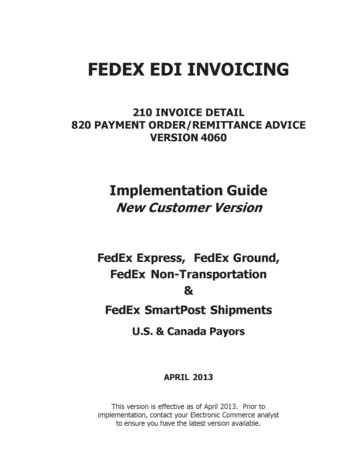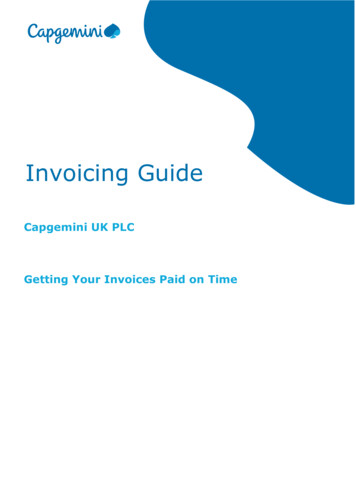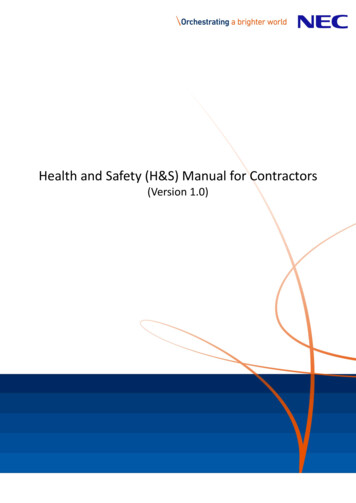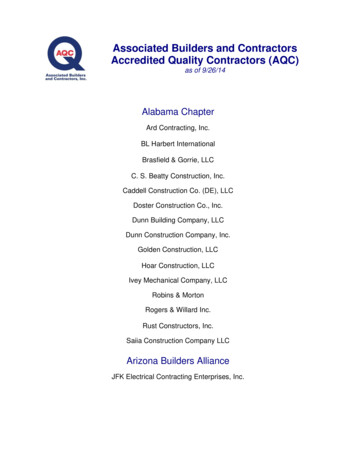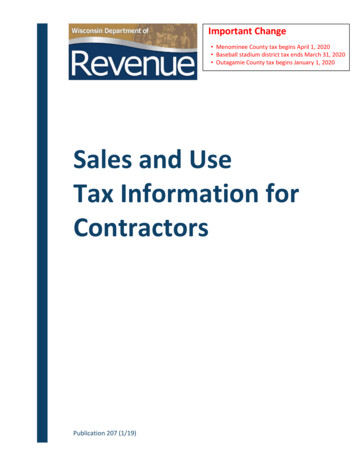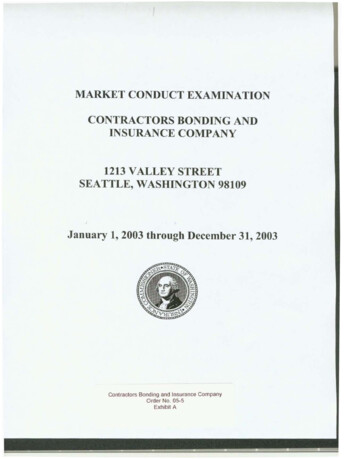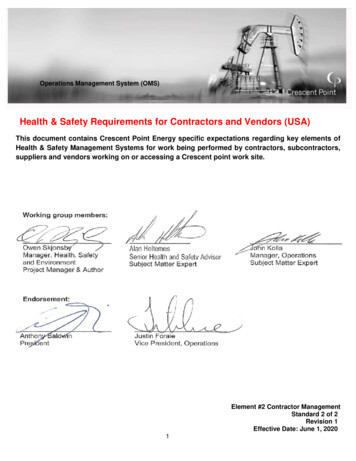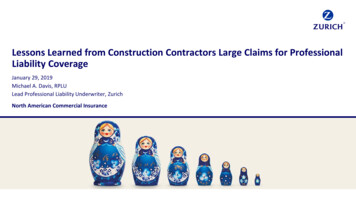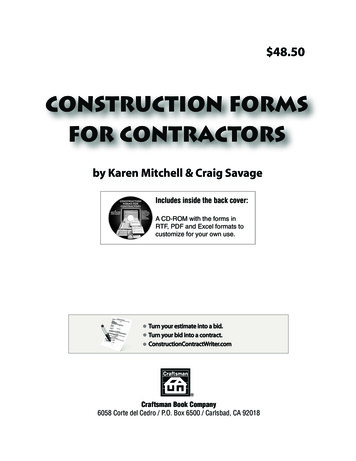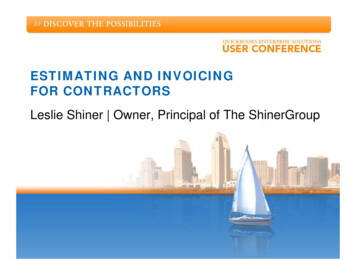
Transcription
ESTIMATING AND INVOICINGFOR CONTRACTORSLeslie Shiner Owner, Principal of The ShinerGroup
Leslie Shiner The ShinerGroup – Owner and Principal Financial & Management Consultant for Contractors MBA in Accounting and Finance from U.C. Berkeley Certified QuickBooks ProAdvisor Certified QuickBooks Enterprise Solution 7.0 CEDIA Certified Trainer, Top 10 Instructor Author: Best Fit Construction Management Software Implementing New Business Management Software Health Checkup for Your Construction Business2
Goals Understand the purposes of estimates and how theyintegrate with purchasing and invoicing Create progress billings based on percentage ofcompletion (AIA) Generate Time and Material (T&M) billings withmultiple wage rates Customize invoices and create invoice templates Apply payments or credits and create statements forcustomers Implement a process to create estimates for each job3
Agenda Why use an estimate? Summary estimate as basis for proposal, progressbilling, milestone billing Detailed estimates as basis for purchasing and jobcosting Time and Material invoicing (T&M) Invoices and cash receipts Change order management4
Contractor 101 – Job Costing Basics Job costing steps Create a job Create an estimate Code all direct costs (COGS) to the job Determine revenue Create invoices to the client for more than the bills Or sell project for more than the cost Measure profit Take the money to the bank! But life is not that simple5
Agenda Why use an estimate? Summary estimate as basis for proposal, progressbilling, milestone billing Detailed estimates as basis for purchasing and jobcosting Time and Material invoicing (T&M) Invoices and cash receipts Change order management6
Create the Estimate Every job must have an estimate To utilize QuickBooks reports “QuickBooks is not an estimating program” But every estimate belongs in QuickBooks What items should you use in an estimate? CSI divisions as a basis (per sample company) Don’t let the project manager rule over the item list Is your item list used for inventory? What does the estimate look like? It depends on: Will you use it to create a purchase order? Will you use it to create an invoice? Will you use it to create a progress bill? Will you use it to send to the client?7
What Should the Estimate Provide? Establishes a budget that provides a basis for: Comparing estimated costs to actual costs Managing the project Evaluating the project after completion Provides the basis for the proposal and subsequentprogress billing Add overhead to budget Then: add profit to arrive at the price “OH&P” is not one word Provides item lists for Purchase Orders8
The Item List is the Key Items are used for: Estimates/Proposals Job Costing Purchase Orders Invoicing You may need to create different items forestimating, invoicing, and/or purchasing Can you use the same items list? What items do you need? Subtotal items work best for job costing Specific items work best for purchase orders General items work best for progress billings9
“Items” Tips Use Subitems To group items on list together Easier to find items Group items Combine several items Can hide detail on printed documents Subtotal items Used for creating invoices with subtotals Other Charge items To show markup on a separate line Item names can be changed on Invoices No need to create an item for everything you invoice10
Agenda;Why use an estimate? Summary estimate as basis for proposal, progressbilling, milestone billing Detailed estimates as basis for purchasing and jobcosting Time and Material invoicing (T&M) Invoices and cash receipts Change order management11
Estimate as Basis for Proposal Summary items to show to a client Can be based on CSI (Construction SpecificationInstitute) format Excellent for Progress Billing (AIA)12
Customize Header and Columns Decide columnsyou need to useon screen Decide columnsclient sees onProposal Change titles Customize header Create professionallooking Proposal13
Markup? Know Your CostsProfitNegotiableOverheadDirect otiablewithout changeof scope14
Markup – Two Different Methods1. Include markup as column (previous example) Combine OH&P only for presentation purposes for client2. Include markup as row Add subtotal line Create item for “Contractors Fee” on separate line Use “Other Charge” item Multiplies number above by percentage Also good if markup on material and not on labor15
Use Estimate to Create Progress Bill Create Invoice From Estimate screen From Customer screen Select the Estimate Choose selected items with different percentages16
Progress Billing by Percentage May be acceptable in place of AIA billing (Sometimes referred to as G702/3) Can also use 3rd party software (Sunburst)17
Estimate as Basis for Milestone Billing Excellent tool for simplified proposal to client Excellent tool for simplified invoicing to client Not useful for comparing actual costs to estimatedcost18
Items as Basis for Milestone Billing Estimate uses only one item (FP Billing)Enter item and change descriptionEnter quantity as percentage of total contractEnter amount as total contract on each line item19
Create Invoice from Estimate Invoice each specific line item Be sure to decide Preferences Jobs and Estimates “Don’t print items that have zero amount” Uncheck to show to the clients Prior amounts invoiced Current amounts in invoice Future amounts to invoice later Remind yourself to invoice client Use To-Do list20
Agenda;Why use an estimate?;Summary estimate as basis for proposal, progress billing, milestone billingDetailed estimates as basis for purchasing and jobcostingTime and Material invoicing (T&M)Invoices and cash receiptsChange order management21
Create Detailed Estimate Create subtotal items for clarity Create classes for better job cost reporting Create detailed Purchase Orders22
Use Detailed Estimate to Create PO’s Create Purchase Orders Assign vendors to items Select items to include Verify against inventory23
But What About Job Costing? Goal of job costing – compare apples to apples Will you use the same items for job costing as youdo for estimating? Perhaps you need to create a second estimate withdifferent items Jobs can (and sometimes should) have multiple estimates Can select which estimate is active depending on needs (jobcosting vs. invoicing) Job Estimates vs. Actuals Summary or Detail Must have an estimate to run this report If items on estimate do not match job costing, detail report maynot have value24
Difference Between a Budget and an Estimate Estimate is very detailed and used for pricing allaspects of the job QuickBooks was not designed as an estimating program QuickBooks integrates with many outside estimating programs Such as: WinEst, CoreCon, Xactimate to name a few Budget is very general and used to compare actualcosts to budgeted costs Therefore, you decide the level of detail of youritems in the estimate and the budget Use subitems to solve this problem25
Use Subitems When estimate has more detail than you can use forcosts Or - when job costs are more detailed than estimate Collapse the report for better tracking26
Using Classes in the Estimate Create class for each cost type Material Labor Equipment Subcontract Code estimates items by class Code costs by item by class Analyze estimated costs to actual costs by class aswell as item Create Job Estimate vs. Actuals – modify report todisplay columns by Class27
Agenda;Why use an estimate?;Summary estimate as basis for proposal, progressbilling, milestone billing;Detailed estimates as basis for purchasing and jobcosting Time and Material invoicing (T&M) Invoices and cash receipts Change order management28
T&M Invoicing (Time & Material) Sometimes referred to as “Cost Plus” Does not require an estimate In fact, do not use estimate to create invoice (click cancel) Must track billable expenses by job or time by job Reason to use items!29
Must Job Cost to Create T&M Invoice Enter items or expenses If you use expenses: Directly code to General Ledger account But, you can only make overhead costs billable COGS expenses cannot be billable Another reason to use items!30
Pick Items To Include Can summarize to one line item Pick from time, expenses, mileage and items Mileage and time not necessarily tied to GL31
Add Subtotal, Add Markup Add subtotal items for better presentation as well asdifferent markups Some contractors include markup in labor billing rate and onlyshow “markup” for materials Add markup item (some still call it OH&P for clients) Automatically multiplies previous amount times percent32
Price Levels Without Price Level, sales price (standard rate)from item is pulled into invoice With Price Level, you can assign different sales priceto customers or jobs Enter in Additional Information Tab Can set sales price by item. Example: Carpentry charged at 85 per hour Electrical charged at 95 per hour Can set amount as percentage markup (or discount)of price Adds or subtracts set percentage to default sales price Used to create global discounts or surcharge to jobs Create price level as a list33
Create a Price Level34
Billing Rate Levels Billing Rate Level allows you to assign different salesprice by employee or vendor Can set custom hourly rate per service item. Example: Carpenter charged at 85 per hour Forman charged at 95 per hour Can set fixed hourly rate for all items per billing rate Example: Project Manager at 95 for any item worked on job First: Create billing level as a list Second: Assign billing level to employees and/orsubcontractors (vendors) Additional information tab Used only for invoicing – does not affect payroll A "per item" price level overrides both billing rate levelsand standard rates35
Create Billing Rate and Then Assign ItEmployeeVendor36
T&M Tips and Tricks Can bill for subcontractors and/or employees byhour without processing in accounting If you need to bill subcontractor by hour, enter timecard Beware! Is this a subcontractor or an employee? The IRS may decide differently than you! Be careful when voiding T&M invoice Items will not become billable again New to 2007 – cannot preview without saving Added to prevent fraud But check out your preferences! (Release 6) General, Company: uncheck “Save transactions beforeprinting”37
Agenda;Why use an estimate?;Summary estimate as basis for proposal, progressbilling, milestone billing;Detailed estimates as basis for purchasing and jobcosting;Time and Material invoicing (T&M) Invoices and cash receipts Change order management38
Invoices Keep them simple Save and print Can email as PDF Include in statements Invoice date is crucial to true accrual accounting Income recognized based on invoice date Create terms Make sure all customers and jobs have valid terms Set in Additional Information tab Otherwise, aging report is always wrong Workaround: Customize to use “ship date” for datemailed to show to clients instead of invoice date39
Other Tips and Tricks for Customization Customize your invoices and estimates Lists, Templates Always make a copy – Never edit canned invoices Visit the Template Gallery for more options Lists, Templates, Templates, Download Templates http://www.quickbooksgroup.com/qblibrary/forms/ Form templates for estimates, invoices, and more! Customize to export to Word using “Letters” See help: Microsoft Word Letters Can create templates in Word for more customization40
Receive Money from Clients Two step process: Receive payments Then, make deposits Run Open A/R Invoice report regularly Did someone create an invoice and then make deposit? Are you double counting income? Creating Customer Credits QuickBooks now asks if you want to apply it to an invoice Newer versions (2005 and later) Sometimes, you should say “No!” Do you need to show credit on statement?41
Agenda;Why use an estimate?;Summary estimate as basis for proposal, progressbilling, milestone billing;Detailed estimates as basis for purchasing and jobcosting;Time and Material invoicing (T&M);Invoices and cash receipts Change order management42
Change Orders Any changes to an estimate can be noted on original estimate Specific to Contractor VersionRecord changes to both sides: Update estimate to change budgeted costs Include markup to change the estimated revenue as wellYou decide how to record changes orders Do it the old way – create another estimate Do it the new way – modify the estimate and save as changeorderBoth ways will update total budgeted costs Better to use change orders to communicate changes to client Provide detail – what has changed and why it changedDepends on how change order will be integrated into invoicing43
Change Orders – Flexibility You can decide when you change an Estimate Add Change Order? It will show on the Estimate as separate section Do you wantthe changeintegrated or asseparate lines?44
Change Order Management Must add to estimate if you want to include onProgress Bills Do you want the change integrated or as separate lines? May need to create a new job if you need to bill T&M Create a contract job and bill milestones Create a change order as a different job and bill T&M45
The 80/20 Rule – Pareto’s Principle The 80/20 rule means that in anything, 20% is vitaland 80% is trivial Focus on that 20%, don’t get lost in the 80% The more complex the estimate, the less value in thereport In fact, the more detailed information, the less valuable thereporting becomes Create process that would work for anyonereviewing the job Do not rely on information “in your head”46
Session Summary The type of estimate you create is a function of whyyou are creating an estimate Detail vs. Summary – you decide Use QuickBooks for all your invoicing needs,including Progress Billing (AIA), Milestone Billing,T&M Billing No one method is standard. Use the flexibility withEnterprise to work for you Use estimates to jump-start your projectmanagement with Purchase Orders and Job CostReports47
Agenda;Why use an estimate?;Summary estimate as basis for proposal, progressbilling, milestone billing;Detailed estimates as basis for purchasing and jobcosting;Time and Material invoicing (T&M);Invoices and cash receipts;Change order management;48
Questions and Answers
Thank YouLeslie C. ShinerOwner/ PrincipalThe ShinerGroupL Shiner@ShinerGroup.com(415) 383-6255www.ShinerGroup.com50
3 Goals Understand the purposes of estimates and how they integrate with purchasing and invoicing Create progress billings based on percentage of completion (AIA) Generate Time and Material (T&M) billings with multiple wage rates Customize invoices and create invoice templates Apply pa
